Wildlife Fences to Mitigate Human–Wildlife Conflicts in Africa: A Literature Analysis
Abstract
1. Introduction
2. Materials and Methods
2.1. Publication Search Criteria
2.2. Data Extraction and Analysis
3. Results
3.1. Temporal and Spatial Representation of Publications
3.2. Reasons for Fencing
3.3. Types of Fences
3.4. Effectiveness of Fences
3.5. The Most Targeted Species by Fencing
3.6. Species That Are Uncontrolled by Fences
3.7. Damage Caused to Fences
3.8. Cost and Maintenance of Fences
4. Discussion
5. Conclusions
Author Contributions
Funding
Institutional Review Board Statement
Data Availability Statement
Acknowledgments
Conflicts of Interest
References
- Smith, D.; King, R.; Allen, B.L. Impacts of Exclusion Fencing on Target and Non-Target Fauna: A Global Review. Biol. Rev. 2020, 95, 1590–1606. [Google Scholar] [CrossRef] [PubMed]
- Pfeifer, M.; Packer, C.; Burton, A.C.; Garnett, S.T.; Loveridge, A.J.; MacNulty, D.; Platts, P.J. In Defense of Fences. Science 2014, 345, 389. [Google Scholar] [CrossRef] [PubMed]
- Clevenger, A.P.; Chruszcz, B.; Gunson, K.E. Highway Mitigation Fencing Reduces Wildlife-Vehicle Collisions. Wildl. Soc. Bull. 2001, 29, 646–653. [Google Scholar]
- Jaeger, J.A.G.; Fahrig, L. Effects of Road Fencing on Population Persistence. Conserv. Biol. 2004, 18, 1651–1657. [Google Scholar] [CrossRef]
- Puky, M. Amphibian Mitigation Measures in Central-Europe; ICOET 2003 Proceedings; UC Davis Institute of the Environment: Davis, CA, USA, 2003; pp. 413–429. Available online: https://escholarship.org/uc/item/5bb7k6t9 (accessed on 4 November 2024).
- Klar, N.; Herrmann, M.; Kramer-Schadt, S. Effects and Mitigation of Road Impacts on Individual Movement Behavior of Wildcats. J. Wildl. Manag. 2009, 73, 631–638. [Google Scholar] [CrossRef]
- Santilli, F.; Mazzoni della Stella, R. Electrical fencing of large farmland area to reduce crops damages by wild boars Sus scrofa. Agric. Mediterr. 2006, 136, 1–6. [Google Scholar]
- Hansen, K.; Mettler, D.; Schiess, A. Effectiveness of fences at protecting livestock from wolves. CDPnews 2020, 19–24. [Google Scholar]
- Carpio, A.J.; Apollonio, M.; Acevedo, P. Wild Ungulate Overabundance in Europe: Contexts, Causes, Monitoring and Management Recommendations. Mammal Rev. 2021, 51, 95–108. [Google Scholar] [CrossRef]
- Beier, P.; Majka, D.; Newell, S.; Garding, E. Best Management Practices for Wildlife Corridors. North. Ariz. Univ. 2008, 1, 1–14. [Google Scholar]
- Hansom, J.D.; Gordon, J.E. Antarctic Environments and Resources: A Geographical Perspective; Routledge: London, UK, 2013; pp. 1–416. [Google Scholar]
- Fernando, C.; Weston, M.A.; Corea, R.; Pahirana, K.; Rendall, A.R. Asian Elephant Movements between Natural and Human-Dominated Landscapes Mirror Patterns of Crop Damage in Sri Lanka. Oryx 2023, 57, 481–488. [Google Scholar] [CrossRef]
- Forsyth, D.M. Using Exclusion Fencing to Manage Feral Deer Impacts in Australia; NSW Department of Primary Industries, Orange, for the Centre for Invasive Species Solutions: Canberra, Australia, 2023. [Google Scholar]
- Philip, J. The Dingo Barrier Fence: Presenting the Case to Decommission the World’s Longest Environmental Barrier in the United Nations Decade on Ecosystem Restoration 2021–2030. Biol. Futur. 2022, 73, 9–27. [Google Scholar] [CrossRef] [PubMed]
- Cohen, J.E. World Population in 2050: Assessing the Projections. In Proceedings of the Conference Series-Federal Reserve Bank of Boston; Federal Reserve Bank of Boston: Boston, MA, USA, 1998; Volume 46, pp. 83–113. [Google Scholar]
- van Dam, A.; van Engelen, W.; Müller-Mahn, D.; Agha, S.; Junglen, S.; Borgemeister, C.; Bollig, M. Complexities of Multispecies Coexistence: Animal Diseases and Diverging Modes of Ordering at the Wildlife–Livestock Interface in Southern Africa. Environ. Plan. E Nat. Space 2024, 7, 353–374. [Google Scholar] [CrossRef]
- Pekor, A.; Miller, J.R.; Flyman, M.V.; Kasiki, S.; Kesch, M.K.; Miller, S.M.; Uiseb, K.; Van der Merve, V.; Lindsey, P.A. Fencing Africa’s Protected Areas: Costs, Benefits, and Management Issues. Biol. Conserv. 2019, 229, 67–75. [Google Scholar] [CrossRef]
- Page, M.J.; McKenzie, J.E.; Bossuyt, P.M.; Boutron, I.; Hoffmann, T.C.; Mulrow, C.D.; Shamseer, L.; Tetzlaff, J.M.; Akl, E.A.; Brennan, S.E.; et al. The PRISMA 2020 Statement: An Updated Guideline for Reporting Systematic Reviews. BMJ 2021, 372, n71. [Google Scholar] [CrossRef] [PubMed]
- Burudi, J.; Katona, K.; Kovács, E.T. A Review of the Human Wildlife Conflicts around the Nairobi National Park, Kenya. Rev. Agric. Rural Dev. 2023, 12, 80–87. [Google Scholar] [CrossRef]
- Oman, D.; Journals, C. Human-Wildlife Conflicts in Africa: A Preliminary Review. Int. J. Environ. Sci. 2024, 13, 6–14. [Google Scholar]
- Edet, D.; Ovat, O.D.; Suleiman, I.D. Human-Wildlife Conflict in Africa: A Review. In Proceedings of the 2nd Wildlife Society of Nigeria (WISON) Conference, Akure, Nigeria, 16–19 September 2018; pp. 196–207. [Google Scholar]
- Nicole, B.-F. An Assessment of the Human-Wildlife Conflict across Africa. In Wildlife Population Monitoring; IntechOpen: London, UK, 2019. [Google Scholar] [CrossRef]
- Kesch, M.K.; Bauer, D.T.; Loveridge, A.J. Break on Through to the Other Side: The Effectiveness of Game Fencing to Mitigate Human-Wildlife Conflict. Afr. J. Wildl. Res. 2015, 45, 76–87. [Google Scholar] [CrossRef]
- Trinkel, M.; Fleischmann, P.H.; Slotow, R. Electrifying the Fence or Living with Consequences? Problem Animal Control Threatens the Long-Term Viability of a Free-Ranging Lion Population. J. Zool. 2017, 301, 41–50. [Google Scholar] [CrossRef]
- O’Neill, H.; Durant, S.; Strebel, S.; Woodroffe, R. Fencing Affects African Wild Dog Movement Patterns and Population Dynamics. Oryx 2022, 56, 128–136. [Google Scholar] [CrossRef]
- Dupuis-Desormeaux, M.; Kaaria, T.N.; Kinoti, J.; Paul, A.; Gilisho, S.; Kobia, F.; Onyango, R.; Chege, G.; Kimiti, D.; Mwololo, M.; et al. Human-Wildlife Conflicts in Communities Bordering a Savannah-Fenced Wildlife Conservancy. Afr. J. Ecol. 2023, 61, 628–635. [Google Scholar] [CrossRef]
- Thouless, C.R.; Sakwa, J. Shocking Elephants: Fences and Crop Raiders in Laikipia District, Kenya. Biol. Conserv. 1995, 72, 99–107. [Google Scholar] [CrossRef]
- Bonnington, C.; Grainger, M.; Dangerfield, S.; Fanning, E. The Influence of Electric Fences on Large Mammal Movements in the Kilombero Valley, Tanzania. Afr. J. Ecol. 2010, 48, 280–284. [Google Scholar] [CrossRef]
- Osipova, L.; Okello, M.M.; Njumbi, S.J.; Ngene, S.; Western, D.; Hayward, M.W.; Balkenhol, N. Fencing Solves Human-Wildlife Conflict Locally but Shifts Problems Elsewhere: A Case Study Using Functional Connectivity Modelling of the African Elephant. J. Appl. Ecol. 2018, 55, 2673–2684. [Google Scholar] [CrossRef]
- Scheijen, C.P.J.; Richards, S.A.; Smit, J.; Jones, T.; Nowak, K. Efficacy of Beehive Fences as Barriers to African Elephants: A Case Study in Tanzania. Oryx 2019, 53, 92–99. [Google Scholar] [CrossRef]
- Vezina, B.I.; Smith, R.J.; Tiller, L.N. A Neglected Aspect of Human-Elephant Conflict: Fence Damagby Elephants in the Trans Mara, Kenya. Pachyderm 2019, 2019, 78–87. [Google Scholar] [CrossRef]
- Matata, M.T.; Kegamba, J.J.; Mremi, R.; Eustace, A. Electrified Fencing as a Mitigation Strategy for Human-Elephant Conflict in Western Serengeti: Community Perspectives. J. Nat. Conserv. 2022, 70, 126271. [Google Scholar] [CrossRef]
- Mbaiwa, J.; Mbaiwa, O. The Effects of Veterinary Fences on Wildlife Populations in Okavango Delta, Botswana. Int. J. Wilderness 2006, 12, 17–41. [Google Scholar]
- Jori, F.; Etter, E. Transmission of Foot and Mouth Disease at the Wildlife/Livestock Interface of the Kruger National Park, South Africa: Can the Risk Be Mitigated? Prev. Vet. Med. 2016, 126, 19–29. [Google Scholar] [CrossRef]
- Mogotsi, K.; Kgosikoma, O.E.; Lubinda, K.F. Wildlife-Livestock Interface, Veterinary Cordon Fence Damage, Lack of Protection Zones, Livestock Theft and Owner Apathy: Complex Socio-Ecological Dynamics in Foot and Mouth Disease Control in Southern Africa. Pastoralism 2016, 6, 21. [Google Scholar] [CrossRef]
- Weldemichel, T.G.; Lein, H. “Fencing Is Our Last Stronghold before We Lose It All.” A Political Ecology of Fencing Around the Maasai Mara National Reserve, Kenya. Land Use Policy 2019, 87, 104075. [Google Scholar] [CrossRef]
- Eloff, P.; van Niekerk, A. Game, Fences and Motor Vehicle Accidents: Spatial Patterns in the Eastern Cape. S. Afr. J. Wildl. Res. 2005, 35, 125–130. [Google Scholar]
- Collinson, W.J.; Davies-Mostert, H.T.; Davies-Mostert, W. Effects of Culverts and Roadside Fencing on the Rate of Roadkill of Small Terrestrial Vertebrates in Northern Limpopo, South Africa. Conserv. Evid. 2017, 14, 39–43. [Google Scholar]
- Massey, A.L.; King, A.A.; Foufopoulos, J. Fencing Protected Areas: A Long-Term Assessment of the Effects of Reserve Establishment and Fencing on African Mammalian Diversity. Biol. Conserv. 2014, 176, 162–171. [Google Scholar] [CrossRef]
- Evans, L.A.; Adams, W.M. Fencing Elephants: The Hidden Politics of Wildlife Fencing in Laikipia, Kenya. Land Use Policy 2016, 51, 215–228. [Google Scholar] [CrossRef]
- Dupuis-Desormeaux, M.; Davidson, Z.; Pratt, L.; Mwololo, M.; MacDonald, S.E. Testing the Effects of Perimeter Fencing and Elephant Exclosures on Lion Predation Patterns in a Kenyan Wildlife Conservancy. PeerJ 2016, 4, e1681. [Google Scholar] [CrossRef]
- Wilkinson, C.E.; McInturff, A.; Kelly, M.; Brashares, J.S. Quantifying Wildlife Responses to Conservation Fencing in East Africa. Biol. Conserv. 2021, 256, 109071. [Google Scholar] [CrossRef]
- Taylor, W.A.; Child, M.F.; Lindsey, P.A.; Nicholson, S.K.; Relton, C.; Davies-Mostert, H.T. South Africa’s Private Wildlife Ranches Protect Globally Significant Populations of Wild Ungulates. Biodivers. Conserv. 2021, 30, 4111–4135. [Google Scholar] [CrossRef]
- Naha, D.; Periquet, S.; Kilian, J.W.; Kupferman, C.A.; Hoth-Hanssen, T.; Beasley, J.C. Fencing Affects Movement Patterns of Two Large Carnivores in Southern Africa. Front. Ecol. Evol. 2023, 11, 1031321. [Google Scholar] [CrossRef]
- Hering, R.; Hauptfleisch, M.; Jago, M.; Smith, T.; Kramer-Schadt, S.; Stiegler, J.; Blaum, N. Don’t Stop Me Now: Managed Fence Gaps Could Allow Migratory Ungulates to Track Dynamic Resources and Reduce Fence Related Energy Loss. Front. Ecol. Evol. 2022, 10, 907079. [Google Scholar] [CrossRef]
- Naidoo, R.; Du Preez, P.; Stuart-Hill, G.; Jago, M.; Wegmann, M. Home on the Range: Factors Explaining Partial Migration of African Buffalo in a Tropical Environment. PLoS ONE 2012, 7, e36527. [Google Scholar] [CrossRef]
- Naidoo, R.; Beytell, P.; Brennan, A.; Kilian, W.; McCulloch, G.; Stronza, A.; Taylor, R.; Tsholofelo, C.; Songhurst, A. Challenges to Elephant Connectivity From Border Fences in the World’s Largest Transfrontier Conservation Area. Front. Conserv. Sci. 2022, 3, 788133. [Google Scholar] [CrossRef]
- King, L.E.; Douglas-Hamilton, I.; Vollrath, F. Beehive Fences as Effective Deterrents for Crop-Raiding Elephants: Field Trials in Northern Kenya. Afr. J. Ecol. 2011, 49, 431–439. [Google Scholar] [CrossRef]
- Chang’a, A.; de Souza, N.; Muya, J.; Keyyu, J.; Mwakatobe, A.; Malugu, L.; Ndossi, H.P.; Konuche, J.; Omondi, R.; Mpinge, A.; et al. Scaling-up the Use of Chili Fences for Reducing Human-Elephant Conflict Across Landscapes in Tanzania. Trop. Conserv. Sci. 2016, 9, 921–930. [Google Scholar] [CrossRef]
- Ferguson, K.; Hanks, J. The Effects of Protected Area and Veterinary Fencing on Wildlife Conservation in Southern Africa. Parks 2012, 18, 49–60. [Google Scholar]
- Van Eden, M.; Ellis, E.; Bruyere, B.L. The Influence of Human-Elephant Conflict on Electric Fence Management and Perception Among Different Rural Communities in Laikipia County, Kenya. Hum. Dimens. Wildl. 2016, 21, 283–296. [Google Scholar] [CrossRef]
- Hering, R.; Hauptfleisch, M.; Kramer-Schadt, S.; Stiegler, J.; Blaum, N. Effects of Fences and Fence Gaps on the Movement Behavior of Three Southern African Antelope Species. Front. Conserv. Sci. 2022, 3, 959423. [Google Scholar] [CrossRef]
- Pirie, T.J.; Thomas, R.L.; Fellowes, M.D.E. Game Fence Presence and Permeability Influences the Local Movement and Distribution of South African Mammals. Afr. Zool. 2017, 52, 217–227. [Google Scholar] [CrossRef][Green Version]
- Kesch, K.; Bauer, D.; Loveridge, A. Undermining Game Fences: Who Is Digging Holes in Kalahari Sands? Afr. J. Ecol. 2014, 52, 144–150. [Google Scholar] [CrossRef]
- González, L.M.; Montoto, F.G.D.; Mereck, T.; Alves, J.; Pereira, J.; De Larrinoa, P.F.; Maroto, A.; Bolonio, L.; El-Kadhir, N. Preventing Crop Raiding by the Vulnerable Common Hippopotamus Hippopotamus Amphibius in Guinea-Bissau. Oryx 2017, 51, 222–229. [Google Scholar] [CrossRef]
- Mutinda, M.; Chenge, G.; Gakuya, F.; Otiende, M.; Omondi, P.; Kasiki, S.; Soriguer, R.C.; Alasaad, S. Detusking Fence-Breaker Elephants as an Approach in Human-Elephant Conflict Mitigation. PLoS ONE 2014, 9, e91749. [Google Scholar] [CrossRef] [PubMed]
- Jori, F.; Brahmbhatt, D.; Fosgate, G.T.; Thompson, P.N.; Budke, C.; Ward, M.P.; Ferguson, K.; Gummow, B. A Questionnaire-Based Evaluation of the Veterinary Cordon Fence Separating Wildlife and Livestock Along the Boundary of the Kruger National Park, South Africa. Prev. Vet. Med. 2011, 100, 210–220. [Google Scholar] [CrossRef] [PubMed]
- Schumann, M.; Schumann, B.; Dickman, A.; Watson, L.H.; Marker, L. Assessing the Use of Swing Gates in Game Fences as a Potential Non-Lethal Predator Exclusion Technique. S. Afr. J. Wildl. Res. 2006, 36, 173–181. [Google Scholar]
- King, L.; Lawrence, A.; Douglas-Hamilton, I.; Vollrath, F. Beehive Fence Deters Crop-Raiding Elephants. Afr. J. Ecol. 2009, 47, 131–137. [Google Scholar] [CrossRef]
- Goodier, R.; King, L. Bees v Elephants: From Chad to South Africa, Beehive Fences Deter African Elephants from Crops. Appropr. Technol. 2017, 44, 38–41. [Google Scholar]
- Kiffner, C.; Schaal, I.; Cass, L.; Peirce, K.; Sussman, O.; Grueser, A.; Wachtel, E.; Adams, H.; Clark, K.; König, H.; et al. Perceptions and Realities of Elephant Crop Raiding and Mitigation Methods. Conserv. Sci. Pract. 2021, 3, e372. [Google Scholar] [CrossRef]
- King, L.E.; Lala, F.; Nzumu, H.; Mwambingu, E.; Douglas-Hamilton, I. Beehive Fences as a Multidimensional Conflict-Mitigation Tool for Farmers Coexisting with Elephants. Conserv. Biol. 2017, 31, 743–752. [Google Scholar] [CrossRef]
- Huijser, M.P.; Fairbank, E.R.; Camel-Means, W.; Graham, J.; Watson, V.; Basting, P.; Becker, D. Effectiveness of Short Sections of Wildlife Fencing and Crossing Structures along Highways in Reducing Wildlife-Vehicle Collisions and Providing Safe Crossing Opportunities for Large Mammals. Biol. Conserv. 2016, 197, 61–68. [Google Scholar] [CrossRef]
- Fernando, P.; Kumar, M.A.; Williams, A.C.; Wikramanayake, E.; Aziz, T.; Singh, S.M. Review of Human-Elephant Conflict Mitigation Measures Practiced in South Asia; WWF: Gland, Switzerland, 2008. [Google Scholar]
- Dror, S.; Harich, F.; Duangphakdee, O.; Savini, T.; Pogány, Á.; Roberts, J.; Geheran, J.; Treydte, A.C. Are Asian Elephants Afraid of Honeybees? Experimental Studies in Northern Thailand. Mamm. Biol. 2020, 100, 355–363. [Google Scholar] [CrossRef]
- van de Water, A.; King, L.E.; Arkajak, R.; Arkajak, J.; van Doormaal, N.; Ceccarelli, V.; Sluiter, L.; Doornwaard, S.M.; Praet, V.; Owen, D.; et al. Beehive Fences as a Sustainable Local Solution to Human-Elephant Conflict in Thailand. Conserv. Sci. Pract. 2020, 2, e260. [Google Scholar] [CrossRef]
- Morantes-Toloza, J.L.; Renjifo, L.M.; Morantes-Toloza, J.L.; Renjifo, L.M. Live Fences in Tropical Production Systems: A Global Review of Uses and Perceptions. Rev. Biol. Trop. 2018, 66, 739–753. [Google Scholar] [CrossRef]
- Oliveira, T.; Treves, A.; Lopez-Bao, J.V.; Krofel, M. The Contribution of the LIFE Program to Mitigating Damages Caused by Large Carnivores in Europe. Glob. Ecol. Conserv. 2021, 31, e01815. [Google Scholar] [CrossRef]
- Brieger, F.; Strein, M. Wildlife Fencing at German Highways and Federal Roads—Requirements and Management Implications. Wildl. Biol. 2024, e01161. [Google Scholar] [CrossRef]
- Reidy, M.M.; Campbell, T.A.; Hewitt, D.G. Evaluation of Electric Fencing to Inhibit Feral Pig Movements. J. Wildl. Manag. 2008, 72, 1012–1018. [Google Scholar] [CrossRef]
- Walker, R.; Blackburn, J. Biothreat Reduction and Economic Development: The Case of Animal Husbandry in Central Asia. Front. Public Health 2015, 3, 270. [Google Scholar] [CrossRef][Green Version]
- Reinhardt, I.; Rauer, G.; Kluth, G.; Kaczensky, P.; Knauer, F.; Wotschikowsky, U. Livestock Protection Methods Applicable for Germany—A Country Newly Recolonized by Wolves. Hystrix Ital. J. Mammal. 2011, 23, 62–72. [Google Scholar] [CrossRef]
- Schillings, J.; Holohan, C.; Lively, F.; Arnott, G.; Russell, T. The Potential of Virtual Fencing Technology to Facilitate Sustainable Livestock Grazing Management. Animal 2024, 18, 101231. [Google Scholar] [CrossRef]
- Jachowski, D.S.; Slotow, R.; Millspaugh, J.J. Good Virtual Fences Make Good Neighbors: Opportunities for Conservation. Anim. Conserv. 2014, 17, 187–196. [Google Scholar] [CrossRef]
- Cunningham, P.L. Do Swing Gates Prevent Black-Backed Jackal from Entering Commercial Sheep Farms? Namib. J. Environ. 2019, 3, B-7. [Google Scholar]
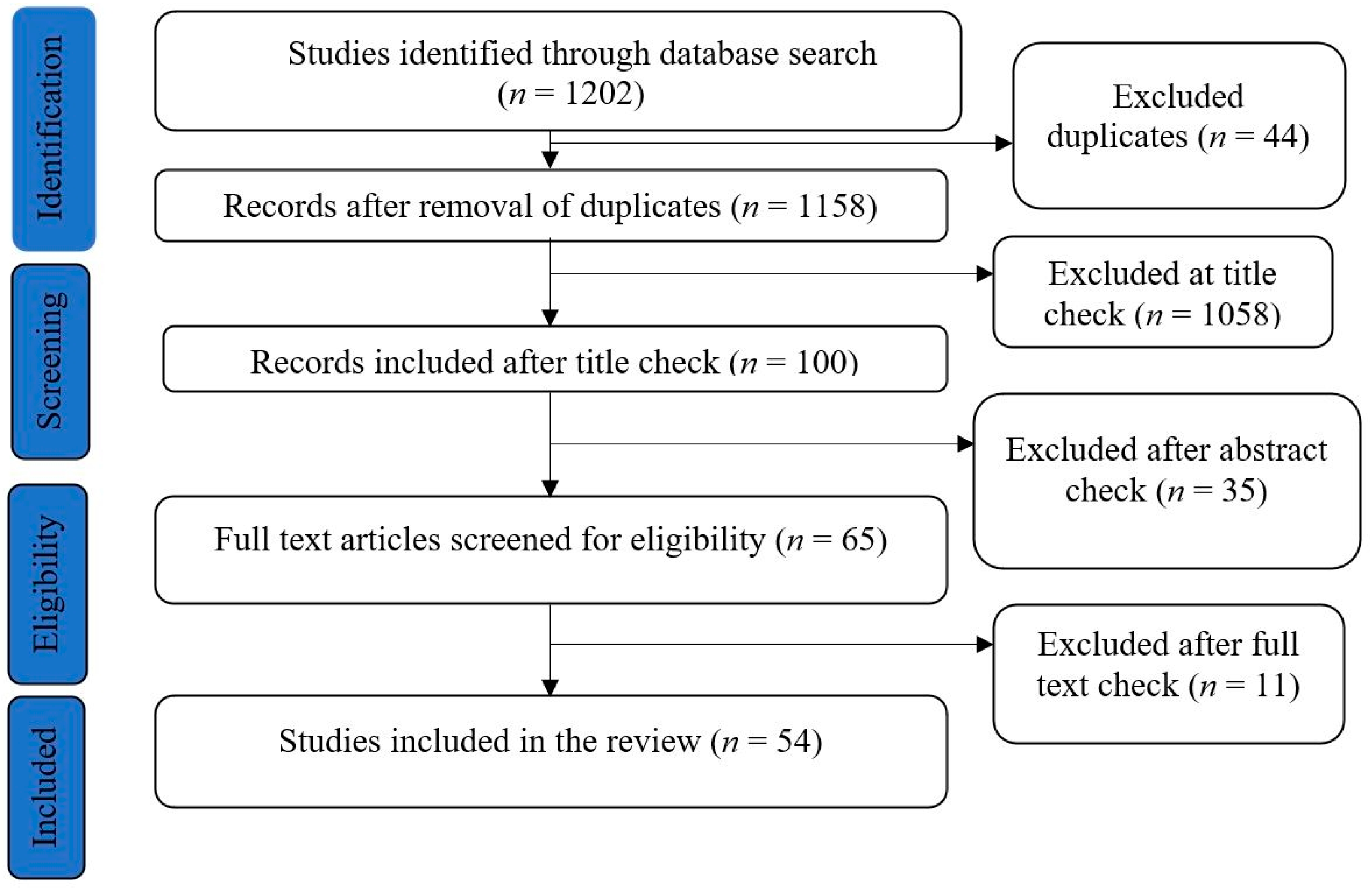
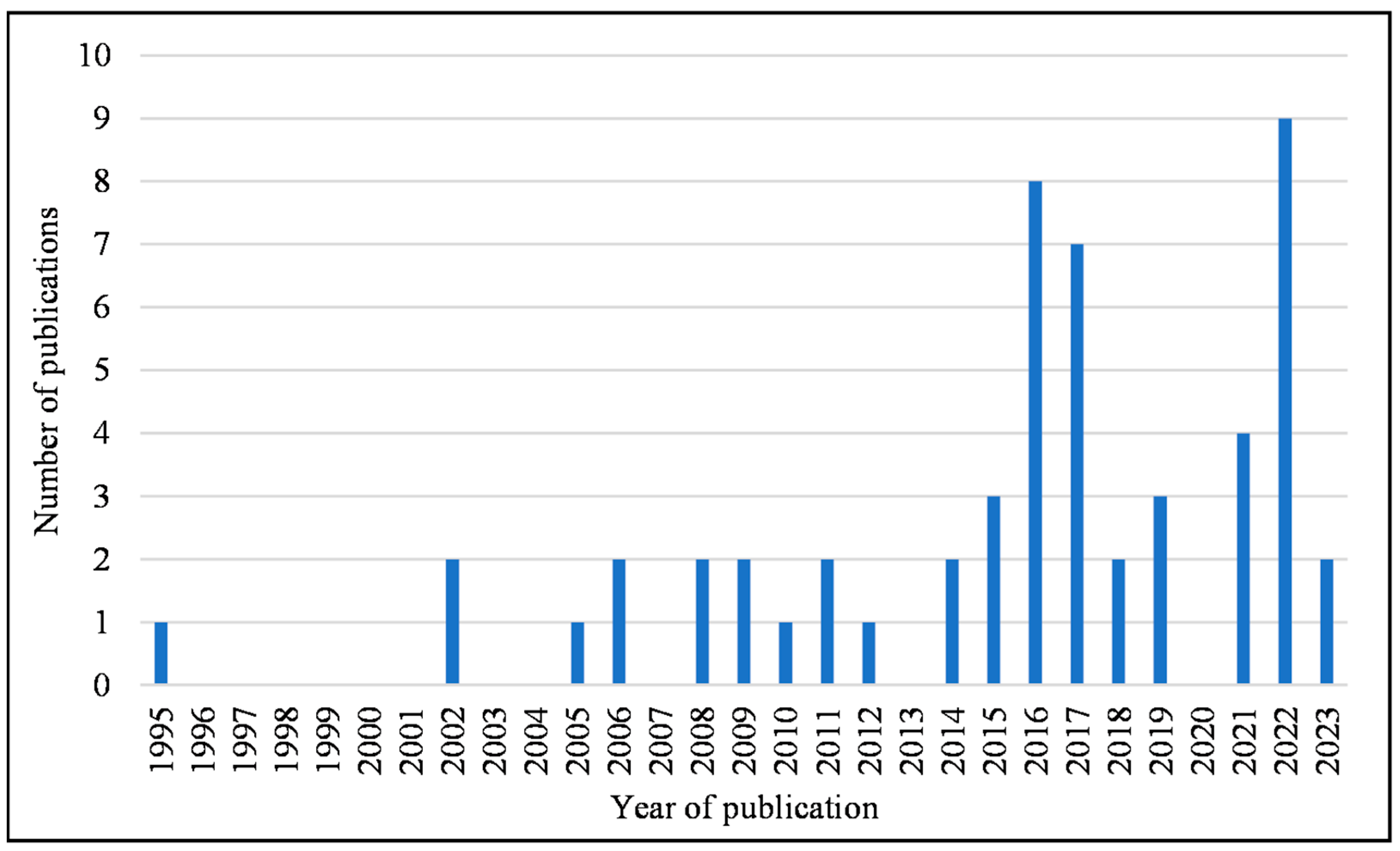
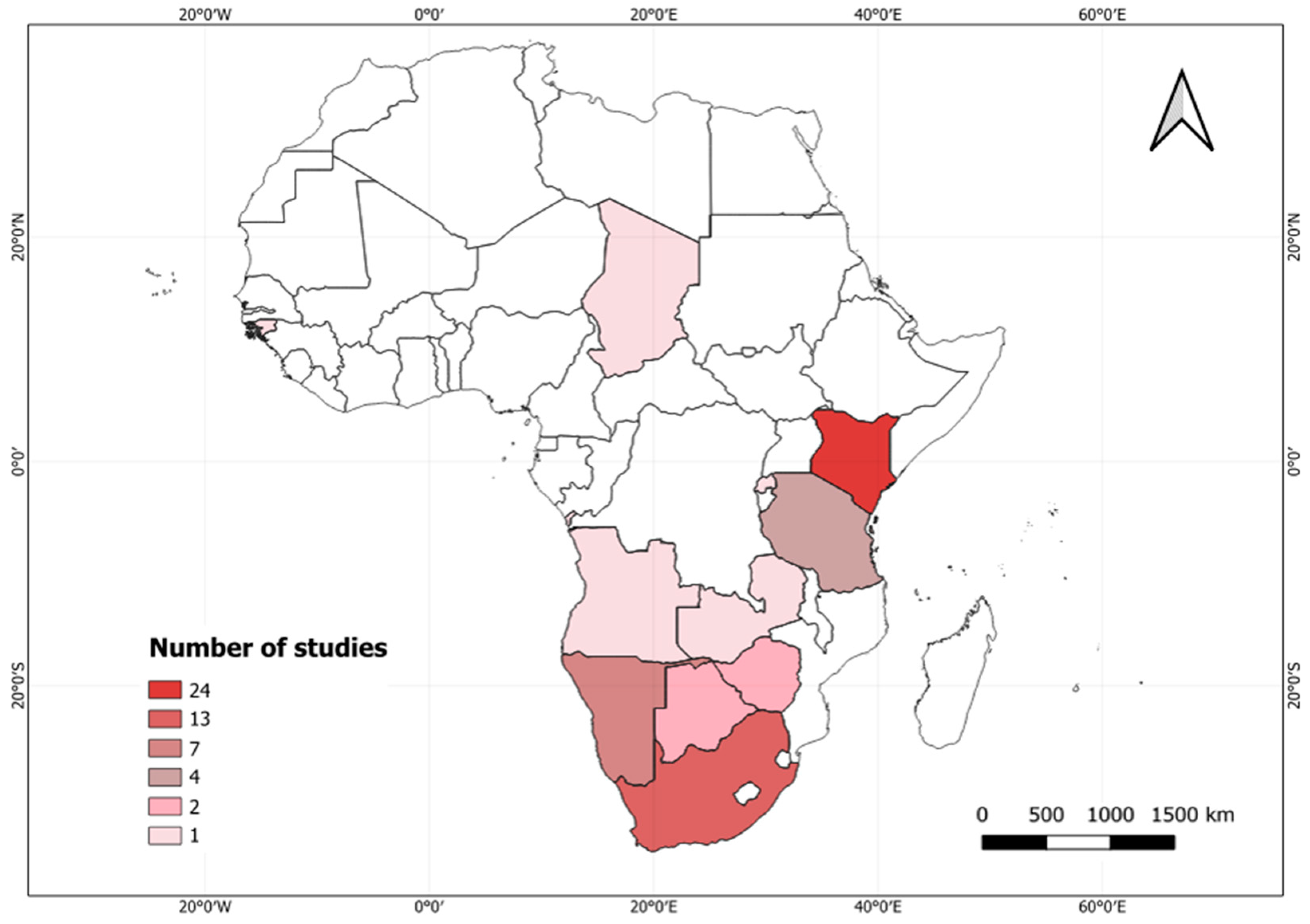
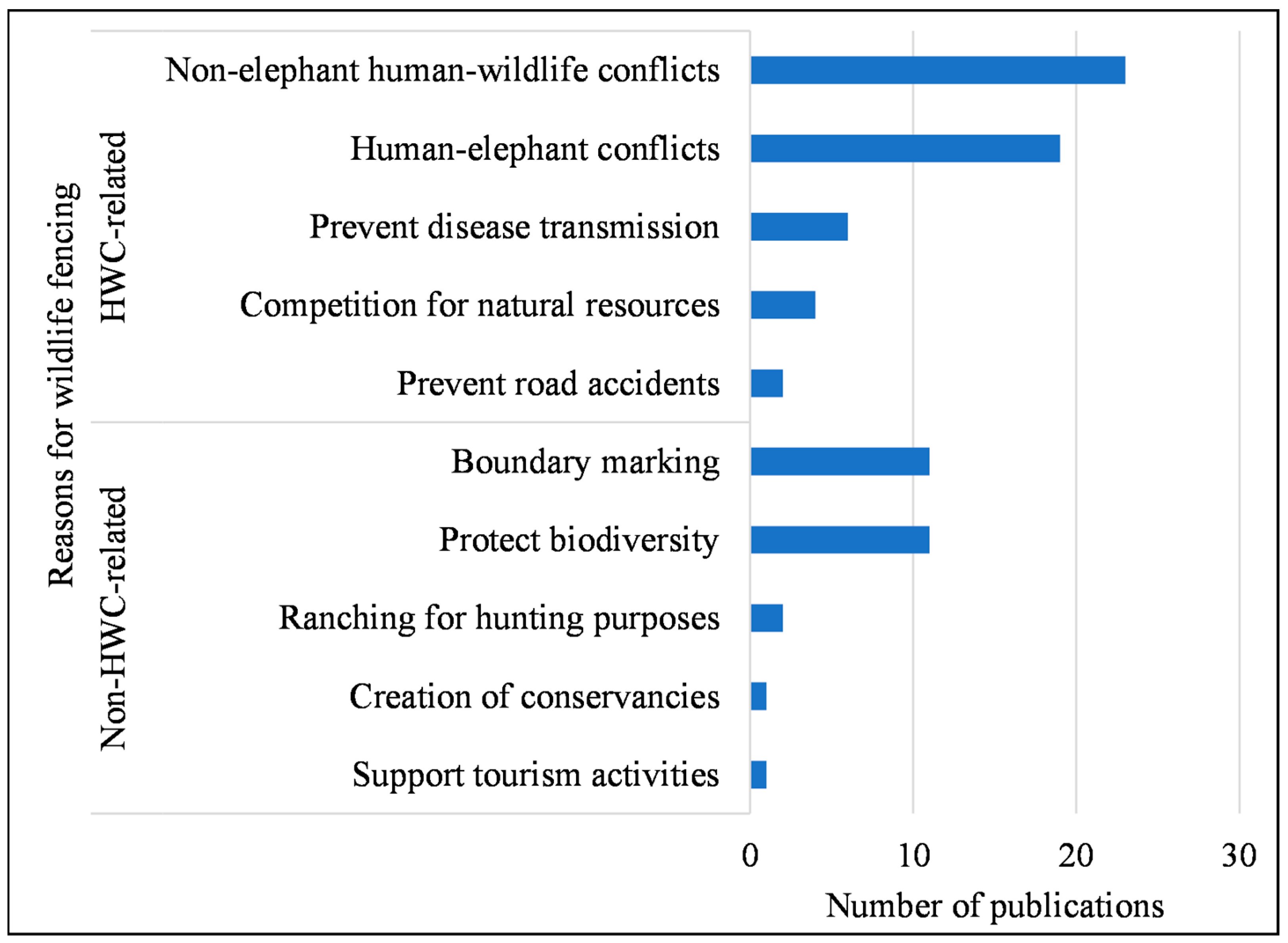

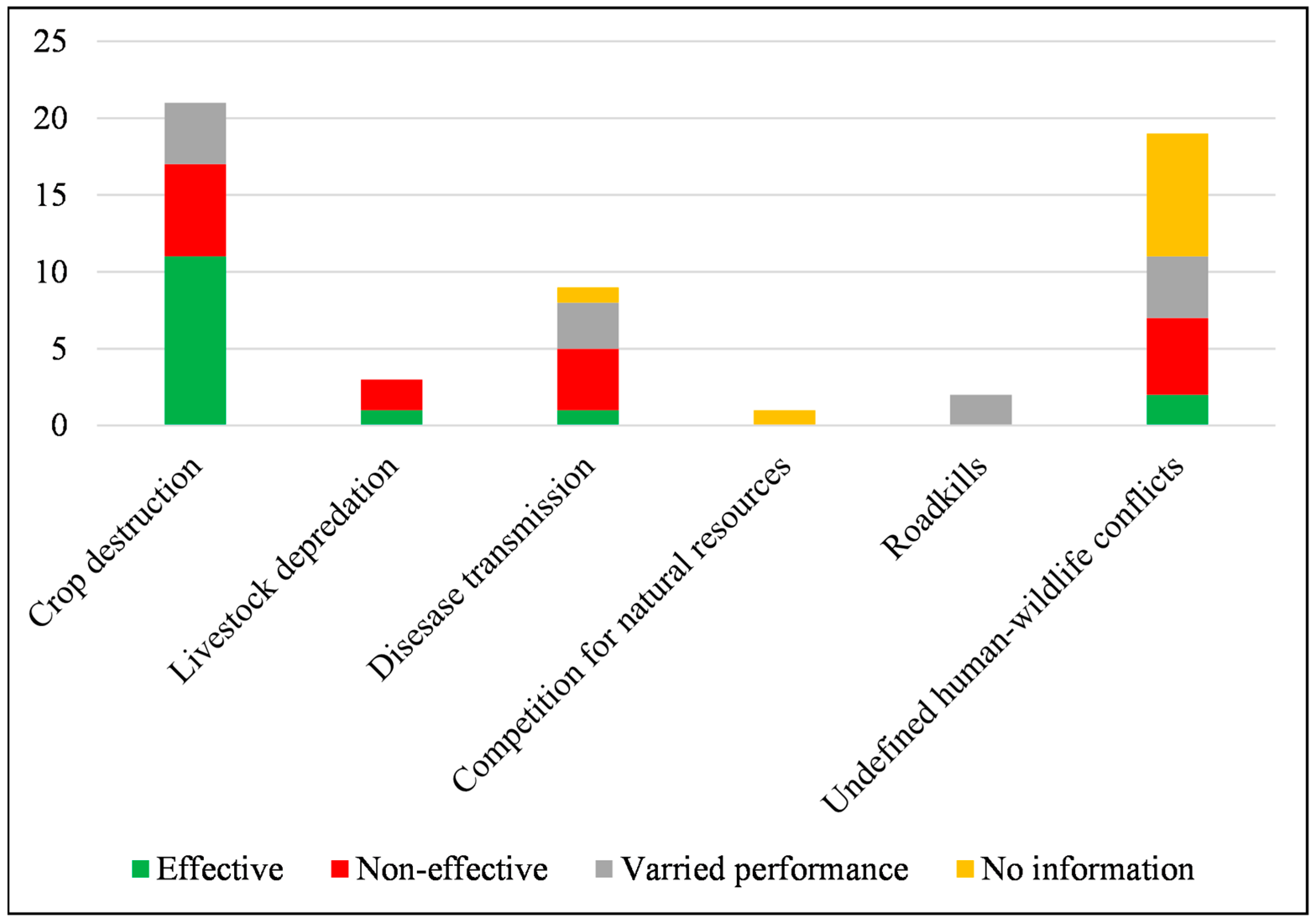

Disclaimer/Publisher’s Note: The statements, opinions and data contained in all publications are solely those of the individual author(s) and contributor(s) and not of MDPI and/or the editor(s). MDPI and/or the editor(s) disclaim responsibility for any injury to people or property resulting from any ideas, methods, instructions or products referred to in the content. |
© 2025 by the authors. Licensee MDPI, Basel, Switzerland. This article is an open access article distributed under the terms and conditions of the Creative Commons Attribution (CC BY) license (https://creativecommons.org/licenses/by/4.0/).
Share and Cite
Burudi, J.W.; Tormáné Kovács, E.; Katona, K. Wildlife Fences to Mitigate Human–Wildlife Conflicts in Africa: A Literature Analysis. Diversity 2025, 17, 87. https://doi.org/10.3390/d17020087
Burudi JW, Tormáné Kovács E, Katona K. Wildlife Fences to Mitigate Human–Wildlife Conflicts in Africa: A Literature Analysis. Diversity. 2025; 17(2):87. https://doi.org/10.3390/d17020087
Chicago/Turabian StyleBurudi, Jocelyn Weyala, Eszter Tormáné Kovács, and Krisztián Katona. 2025. "Wildlife Fences to Mitigate Human–Wildlife Conflicts in Africa: A Literature Analysis" Diversity 17, no. 2: 87. https://doi.org/10.3390/d17020087
APA StyleBurudi, J. W., Tormáné Kovács, E., & Katona, K. (2025). Wildlife Fences to Mitigate Human–Wildlife Conflicts in Africa: A Literature Analysis. Diversity, 17(2), 87. https://doi.org/10.3390/d17020087








